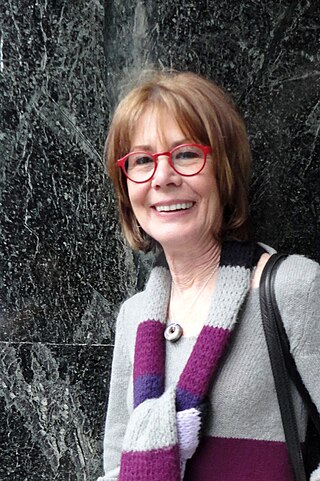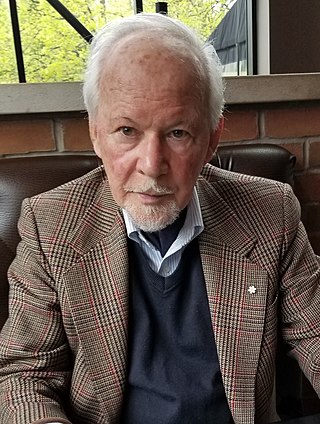Related Research Articles
Nina Raginsky, is a Canadian photographer who received the honour of the Order of Canada in 1984.
Agnes was a Birmingham, Alabama photography gallery from 1993 to 2001. Shawn Boley, Jon Coffelt and Jan Hughes opened the gallery with the mission of attempting to raise awareness of social issues — such as cancer, AIDS, death and dying, the environment, homelessness, ethics, racism, classism, imprisonment — through photojournalism, film, video, poetry, and book arts. Controversial, Agnes was picketed on several occasions, one of which resulted in a USA Today article on December 5, 1994.
Jan Peacock is a Canadian interdisciplinary artist, curator and writer.
George Steeves is a Canadian art photographer noted for his highly personal work. He has been called by art historian and curator Martha Langford, "among the foremost figures of contemporary Canadian photography."

Evergon, also known by the names of his alter-egos Celluloso Evergoni, Egon Brut, and Eve R. Gonzales, is a Canadian artist, teacher and activist. Throughout his career, his work has explored photography and its related forms, including photo-collage, instant photography, colour photocopying, and holography.

Suzy Lake is an American-Canadian artist based in Toronto, Canada, who is known for her work as a photographer, performance artist and video producer. Using a range of media, Lake explores topics including identity, beauty, gender and aging. She is regarded as a pioneering feminist artist and a staunch political activist.
Lorraine Gilbert is a Canadian artist and photographer focusing on landscape as a genre, raising questions pertaining to the social and economic aspects of landscape as art, as nature, and as lived experience. She lives in Ottawa and in Quebec.
Sandra Semchuk is a Canadian photographic artist. In addition to exhibiting across Canada and internationally, Semchuk taught at Emily Carr University of Art and Design from 1987 to 2018.
Nicole Jolicoeur (1947) is a Canadian artist from Quebec, best known for her work in photography and video. In the late 1980s, much of her work was inspired by research into Jean-Martin Charcot's theories on feminine "hysteria."
Angela Grauerholz D.F.A. is a German-born Canadian photographer, graphic designer and educator living in Montreal.
Martha Langford is a Canadian art historian. She is a Distinguished University Research Professor of art history at Concordia University and the Research Chair and Director of the Gail and Stephen A. Jarislowsky Institute for Studies in Canadian Art. She was the founding director of the Canadian Museum of Contemporary Photography and served as its director and chief curator from 1985 until 1994. She is an elected Fellow of the Royal Society of Canada.
Judith Eglington is a Canadian photographer and filmmaker.
Barbara Spohr (1955–1987) was a Canadian photographer.
Sylvie Readman is a Canadian photographer.
John Max was a Canadian photojournalist, photography teacher, and art photographer. He is recognized for his use of the narrative sequence, his expressive portraiture, and his intensely personal, subjective approach to photography by a number of critics, curators, artists, and photographers in Canada and abroad. It has also been the source of a number of responses and homages. Robert Frank said about him "When I think of Canadian photography, his name comes up first."
Holly King is a Canadian artist based in Montreal, known for her photographs of constructed landscapes. She views landscape as a product of the imagination.
Michel Lambeth was a Canadian photographer. He made an in-depth photographic study of Toronto during the 1950s and was one of the country's leading photo-journalists during the 1960s.
Charles Gagnon was a multidisciplinary artist known for his painting, photography and film.

Photographs have been taken in the area now known as Canada since 1839, by both amateurs and professionals. In the 19th century, commercial photography focussed on portraiture. But professional photographers were also involved in political and anthropological projects: they were brought along on expeditions to Western Canada and were engaged to document Indigenous peoples in Canada by government agencies.

James W. Borcoman D.F.A. LL. D., also known as Jim Borcoman, was the founding curator of photography, National Gallery of Canada from 1971 to 1994. He was a pioneer in promoting photography as an art form in Canada, having established the Photographs Collection at the National Gallery in 1967 as the first of its kind in Canada, and developing its growth to over 19,000 objects, resulting in a collection known for the quality of its nineteenth and twentieth century holdings and for its exhibitions and publications. He also promoted contemporary Canadian photographers and was himself a photographer with work in the collection of the National Gallery of Canada.
References
- 1 2 "Penny Cousineau". National Gallery of Canada. Retrieved 27 May 2016.
- 1 2 "Penny Cousineau-Levine". Department of Visual Arts. University of Ottawa. Retrieved 27 May 2016.
- ↑ Martha Langford (2005). Image & Imagination. McGill-Queen's Press - MQUP. pp. 9–. ISBN 978-0-7735-2969-4.
- ↑ RACAR. Society for the Promotion of Art History Publications in Canada. 2007.
- ↑ "Reviews:Faking Death: Canadian Art Photography and the Canadian Imagination". Quill and Quire. 5 January 2004. Retrieved 9 June 2016.
- ↑ Samson, Hélène (2004). "FAKING DEATH. Canadian Art Photography and the Canadian Imagination". Ciel variable Magazine (in French). Retrieved 2018-04-18.